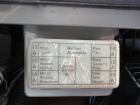How to find the cause of a blown fuse.
Overview
First, compare the fuse Amperage to the specified amps listed on the Fuse Box cover.
- If the fuse is the wrong size, replace it with the correct size.
- If the fuse is the correct size, put a new fuse in and try it again. Sometimes it won't blow again. However if it repeats, start troubleshooting.
Troubleshooting
Does the fuse blow only when a specific accessory is turned on?
- Yes, the fuse blows only with a specific component is operated. In this case, disconnect that part, and try a new fuse.
- If it no longer blows, replace that part.
- The fuse still blows -- indicates a short between the switch and the part. Carefully inspect the wires in between the two. Replace the wire(s) if damage is found. Tape any bare wires.
- No, the fuse problem doesn't seem to be related to any specific item.
- Get out the Wiring Diagram for your vehicle. Trace all the items used by that particular fuse (there will be more items than listed on the Fuse Box cover). Make a list of these components.
- Is the fuse problem steady? In other words, does the fuse blow everytime you replace it?
- Yes, the fuse blows as soon it is put in. In this case, unplug all the components in your list (that you made after examining the wiring diagram). Then put a new fuse in. Hopefully it doesn't blow. Re-connect each component, one by one, until the fuse blow. Now you have found the shorted component.
- No, a new fuse doesn't blow, but it will after some random time. In this case, attempt to pin down the scenario:
- How many people in car when it blows?
- How much cargo when it occurs?
- Was it raining?
- Etc.
- After gathering more details about the problem, try to reproduce the conditions. If this is not succesful, use the brute force effot: trace all the wiring used by that fuse for shorted wires. For example, wires shorted against seat tracks or wires rubbing against parts, burn marks, etc.

![[Datsun 1200 encyclopedia]](/wiki/upload/wiki.png)

